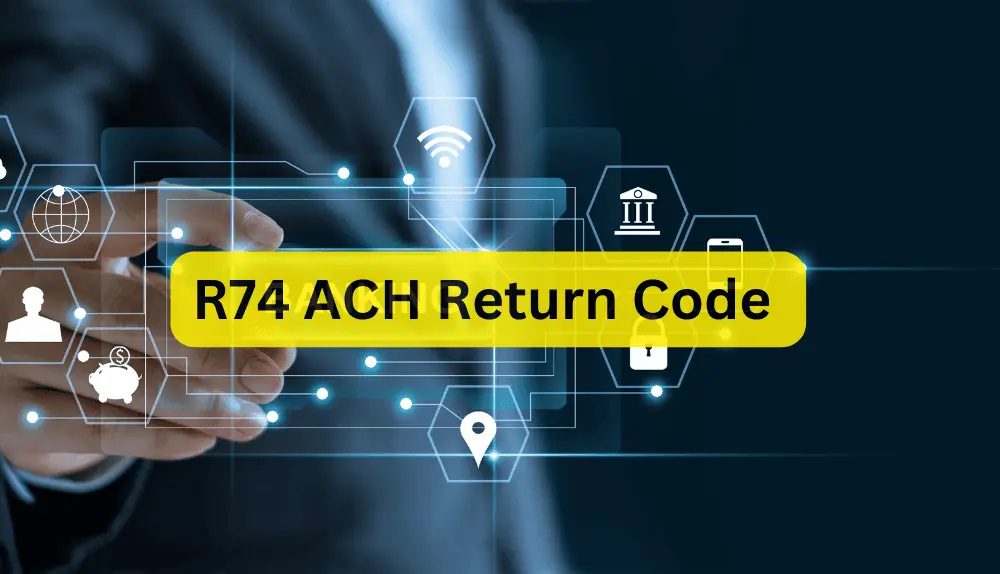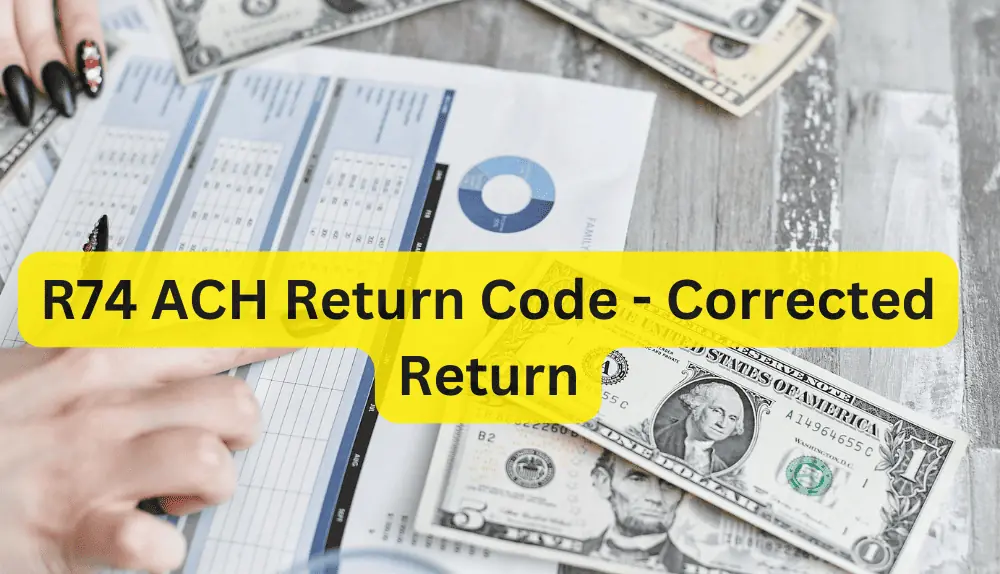Welcome to the world of banking, where every transaction is meticulously scrutinized to ensure seamless financial operations. R74 ACH Return Code is an important code that helps in clarity and accuracy. As the financial universe spins with numerous electronic fund transfers daily, errors are bound to occur, hindering the smooth flow of funds. However, for the Corrected Return, R74 ACH Return Code is crucial and in this article we will understand its importance.
What Does R74 ACH Return Code Mean?
The ACH R74 Return Code represents a Corrected Return within the Automated Clearing House (ACH) network. When an ACH transaction encounters an error or inconsistency, it cannot be processed successfully, resulting in a return of the payment to the originating account. However, with the introduction of the R74 Return Code, the ACH system now possesses the ability to correct certain errors and reprocess the transaction successfully.

This code allows financial institutions to rectify minor mistakes, such as incorrect account numbers or invalid transaction codes, without the need for manual intervention or additional paperwork. The R74 Return Code streamlines the correction process, reducing delays and complexities that often accompany ACH returns.
As a beacon of efficiency and accuracy, the ACH R74 Return Code exemplifies the ongoing efforts within the financial sector to optimize electronic fund transfers and ensure smoother, more reliable transactions. By enabling the swift resolution of errors, it significantly contributes to the overall resilience and effectiveness of the ACH network.
Reasons R74 ACH Return Code Can Occur
The ACH R74 Return Code, also known as the Corrected Return, is a vital mechanism within the Automated Clearing House (ACH) system that allows for the correction and successful reprocessing of ACH transactions that encounter errors during initial processing. Understanding the reasons behind the occurrence of the ACH R74 Return Code is crucial for financial institutions and businesses to streamline their payment processes and ensure smooth electronic fund transfers.
Invalid Account Number
One common reason for the ACH R74 Return Code is an invalid account number. This can happen when the account number provided by the sender is incorrect or does not match the account information on file with the receiving financial institution. Such discrepancies can lead to the rejection of the transaction and the subsequent generation of the R74 Return Code.
Inaccurate Transaction Code
ACH transactions require specific transaction codes to indicate the type of payment being made, such as a direct deposit or a bill payment. If the sender provides an inaccurate transaction code that does not align with the purpose of the payment, the receiving financial institution may return the transaction with the ACH R74 Return Code.
Closed or Inactive Account
When an ACH payment is sent to an account that is closed or inactive, the receiving financial institution cannot process the transaction. In such cases, the payment is returned with the R74 Return Code, indicating the need for corrective action.
Insufficient Funds
Insufficient funds in the account to cover the ACH payment is another common cause for the ACH R74 Return Code. When the receiving account lacks the necessary funds to complete the transaction, the payment is returned, prompting the need for the sender to attempt the transaction again or seek an alternative payment method.
Technical Errors
Sometimes, technical glitches within the ACH system or communication issues between financial institutions can trigger the ACH R74 Return Code. These errors may include system downtime, network disruptions, or processing delays, requiring the transaction to be corrected and reprocessed.
Steps to Fix R74 ACH Return Code
Fixing the ACH R74 Return Code requires thorough investigation, identification of the root cause, and appropriate corrective actions. Below are the steps to address and resolve the ACH R74 Return Code:

Review the Return Report
When an ACH transaction receives the R74 Return Code, the first step is to review the return report provided by the receiving financial institution. This report will contain details about the specific reason for the return, such as an invalid account number, incorrect transaction code, insufficient funds, or other issues.
Verify Transaction Details
Next, verify the transaction details provided in the return report against the original ACH request. Ensure the account numbers, transaction codes, and other payment information are accurate and up-to-date. Double-checking this information will help identify any discrepancies that led to the return.
Contact the Receiving Financial Institution
If the return reason is not clear from the return report or if there are any questions regarding the return, contact the receiving financial institution for further clarification. They can provide additional insights into the specific issue and help determine the corrective action needed.
Correct the Error
Based on the information gathered from the return report and communication with the receiving financial institution, take the necessary corrective actions. This may involve updating the account number, correcting the transaction code, or addressing any other issues that caused the ACH R74 Return Code.
Resubmit the Transaction
After making the necessary corrections, resubmit the ACH transaction for processing. Ensure that all the required changes have been implemented correctly before initiating the reprocessing to avoid encountering the same issue again.
Monitor the Transaction
Monitor the resubmitted transaction closely to confirm its successful processing. Check for any new return codes or issues that may arise during the reprocessing. If the payment goes through without any further problems, the ACH R74 Return Code has been successfully resolved.
Preventative Measures
To prevent future occurrences of the ACH R74 Return Code, consider implementing preventative measures. This may include conducting regular audits of ACH transactions, verifying account information before initiating payments, using secure and reliable payment systems, and staying informed about any changes in ACH rules and regulations.
By following these steps and taking proactive measures, businesses and financial institutions can effectively address and fix the ACH R74 Return Code, ensuring smooth and efficient electronic fund transfers.
How Can Businesses Deal with ACH R74 Return Code
Dealing with the ACH R74 Return Code requires businesses to adopt a systematic and proactive approach. Here are some steps and strategies to effectively handle the ACH R74 Return Code:
Thoroughly Understand the Return Reason
When a business receives the ACH R74 Return Code, the first step is to thoroughly understand the reason behind the return. Review the return report provided by the receiving financial institution, which will outline the specific issue that led to the return. Understanding the root cause is crucial for implementing the right corrective actions.
Verify Customer Information
Ensure the customer’s account information, including account numbers and routing numbers, is accurate and up-to-date. This verification can be done during the onboarding process or before initiating any ACH transactions. Having accurate customer information reduces the likelihood of encountering ACH return codes.
Double-Check Transaction Details
Before submitting ACH transactions, double-check all transaction details, including the transaction code and payment amount. Ensure that the transaction code aligns with the type of payment being made and that it complies with ACH rules and regulations.
Establish Communication Channels
Maintain open communication channels with customers to resolve any issues promptly. If a customer’s account is closed or inactive, the business should reach out to the customer to update their account information and ensure successful future transactions.
Automate Reconciliation Processes
Consider using automated reconciliation processes to match ACH transactions with corresponding receivables. Automated reconciliation can help identify discrepancies or errors early on and facilitate timely corrective actions.
Monitor Transactions Closely
Regularly monitor ACH transactions and review any return reports to identify patterns or recurring issues. Monitoring transaction activity can help detect potential problems and enable businesses to address them proactively.
Implement Error Resolution Procedures
Develop clear and efficient error resolution procedures to handle ACH R74 Return Codes when they occur. Ensure that the necessary staff members are trained to follow these procedures effectively.
Work with a Reputable Payment Processor
Choose a reliable and experienced payment processor that offers robust ACH processing services. A reputable processor can help businesses navigate the complexities of ACH transactions, reduce the occurrence of return codes, and provide guidance when issues arise.
Stay Updated with ACH Rules and Regulations
Keep abreast of any changes in ACH rules and regulations. Compliance with ACH guidelines is essential for minimizing return codes and avoiding potential penalties.
Continuous Improvement
Regularly assess the ACH payment process and identify areas for improvement. Implement feedback mechanisms to gather insights from customers and partners, allowing the business to refine its ACH operations continually.
By adopting these practices and maintaining a proactive approach, businesses can effectively deal with the ACH R74 Return Code, optimize their ACH payment processes, and enhance overall financial efficiency.
Final Words
In conclusion, the ACH R74 Return Code presents both a challenge and an opportunity for businesses operating in the realm of electronic fund transfers. While encountering this code signifies an initial setback, it serves as a valuable signal to review and enhance ACH payment processes.
By understanding the reasons behind its occurrence and implementing the appropriate corrective actions, businesses can mitigate the frequency of ACH R74 Return Codes and improve transaction success rates. Maintaining accurate customer information, double-checking transaction details, and fostering open communication channels are vital steps to prevent returns.
Moreover, businesses should embrace automation, monitor transactions diligently, and collaborate with reliable payment processors to navigate the intricacies of the ACH system. Embracing a continuous improvement mindset, staying updated with ACH rules, and investing in error resolution procedures will further strengthen a business’s ability to handle the ACH R74 Return Code efficiently. In this dynamic financial landscape, proactive measures and a commitment to streamlined processes will empower businesses to not only address the challenges posed by the ACH R74 Return Code but also excel in harnessing the potential of electronic fund transfers for seamless financial transactions.
Frequently Asked Questions (FAQs)
Why did I receive an ACH R74 Return Code on my transaction?
The ACH R74 Return Code is triggered when an ACH transaction encounters an error during initial processing. Common reasons for receiving this code include an invalid account number, incorrect transaction code, insufficient funds, closed or inactive accounts, and technical errors within the ACH system.
How can I resolve the ACH R74 Return Code on my transaction?
To resolve the ACH R74 Return Code, you need to identify the specific reason for the return by reviewing the return report provided by the receiving financial institution. Once the root cause is identified, take appropriate corrective actions, such as updating account information, correcting transaction details, or addressing any other issues. After making the necessary corrections, resubmit the ACH transaction for processing.
Can the ACH R74 Return Code be prevented?
While it may not be entirely avoidable, businesses can take proactive measures to reduce the occurrence of the ACH R74 Return Code. Maintaining accurate customer information, verifying transaction details, and using reliable payment processors can help minimize returns. Regular monitoring of transactions and staying updated with ACH rules and regulations are also essential to prevent potential return issues.
Does the ACH R74 Return Code incur any fees or penalties?
The ACH R74 Return Code may be associated with fees imposed by the receiving financial institution. These fees can vary and are often outlined in the agreement between the business and the financial institution. Additionally, excessive ACH returns can lead to compliance issues and penalties, making it crucial for businesses to address and resolve return codes promptly.
Can the ACH R74 Return Code be appealed or reversed?
In most cases, the ACH R74 Return Code cannot be appealed or reversed directly. However, by understanding the reason for the return and taking corrective actions, businesses can resubmit the corrected transaction for processing successfully.

